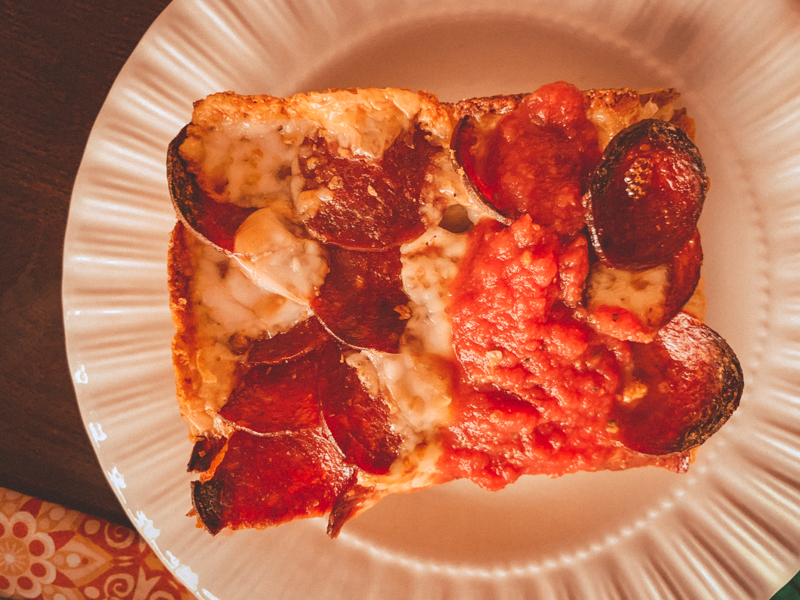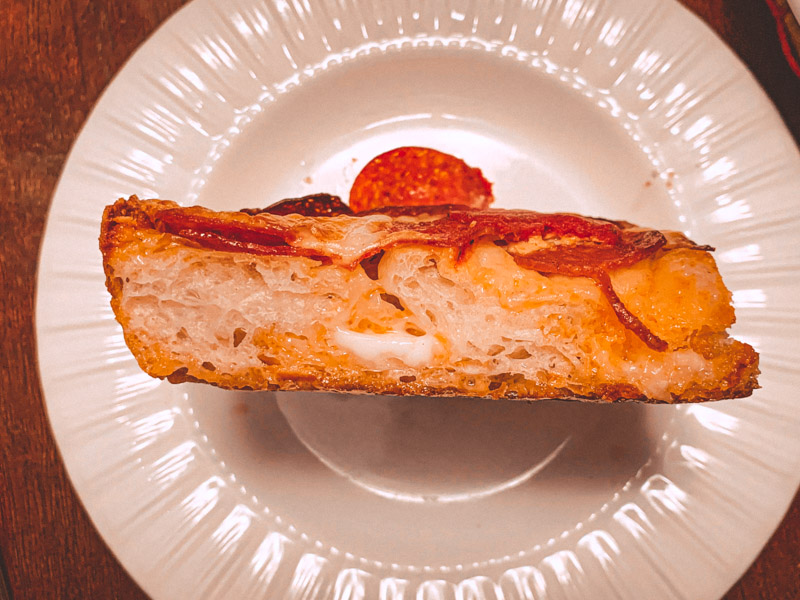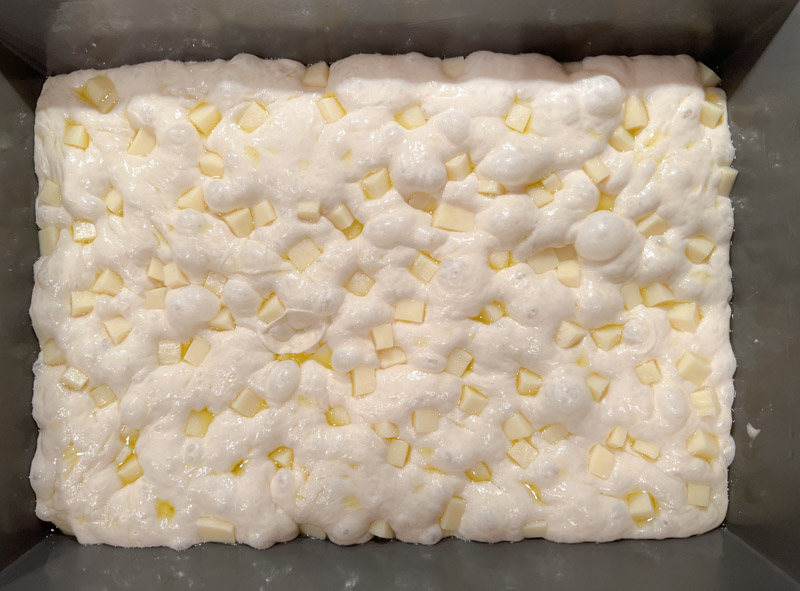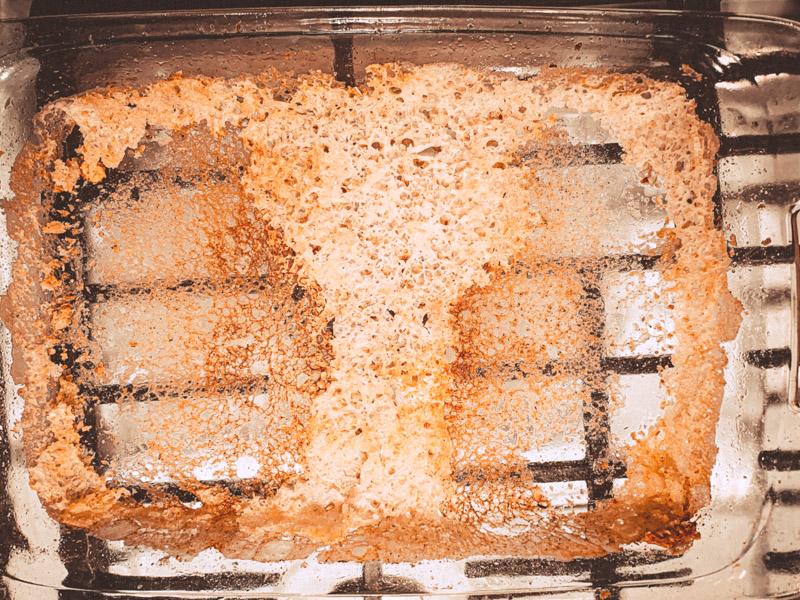Ratings, percentages, and more
rating: 9/8 slices

hydration: 80%

difficulty: moderate

Ingredient percents
| Ingredient | Standard % | Baker’s % |
| Flour (567g) | 53.29% | 100% |
| Salt (11g) | 1.03% | 1.95% |
| Yeast (4g) | 0.38% | 0.70% |
| Water (454g) | 42.67% | 80% |
| Olive Oil (28g) | 2.63% | 5% |
Summary
- Need to start dough the day before.
- A little more effort than other Detroit style recipes but worth it.
- Adding cheese chunks to the dough creates amazing molten cheese pockets in the crust!
I pulled this recipe from Perfect Pan Pizza, by Peter Reinhart.
A Delectable Detroit Style Pizza

To be honest, I didn’t have high expectations for this pizza. I’d already tried several different Detroit style pizza variations and didn’t think there’d be much difference in this one — maybe incrementally better, not substantially though. Wow! I was wrong. This pizza is excellent. My wife ranked it in her top-5 pizzas that I’ve ever made. It’s my new favorite Detroit style pizza, unseating Kenji Lopez-Alt’s version. The bottom of the crust is incredibly crisp, while the interior is airy, light, and filled with the awesome irregular bubbles and air pockets that crust dreams are made of.
Sources of Success

I think the high-hydration dough (80%) plays a role in this recipe’s success but, several preparation techniques also contribute to its glory. The dough uses the fold technique, which I first learned of in King Arthur’s Cheesy Crispy Pan Pizza, instead of traditional kneading. And, Reinhart suggests using a dimpling technique, instead of stretching, to get the dough to fill the pan. He says that avoiding stretching leads to a tender crust. I’ve also seen this technique before, but not expressed as strictly: Reinhart makes clear that you should not stretch the dough at all, even if it takes 4 dimpling sessions, with 20 minutes between each, to get the dough edge-to-edge. But, for me, the really innovative technique, the thing I’ve never seen or heard of, is embedding chunks of cheese into the dough before the final in-pan rise.

The recipe has another new-to-me process: putting the sauce on after baking. I didn’t know if I’d like this but turns out I do because it does two things — it helps the crust stay crispy and allows the pizza to cool faster. I think both of these benefits stem from the reduced moisture, moisture being the enemy of crisp and liquid a solid retainer of heat. Reinhart’s recipe doesn’t include cooking the sauce and, since it’s not on the pizza during baking, it’s completely raw. While I didn’t mind this, I’ve found that I prefer cooking the sauce to blend flavors and reduce runniness.

I Pass on Glass
I made a big miscalculation on the amount of dough that I needed and ended up with enough for two full pizzas. Reinhart says that glass (Pyrex) pans “do work for deep-pan pizza,” although he recommends steel or aluminum. I’d been curious to try glass for a while, and, when I first made this recipe only had one Detriot style pan. So I made a second pizza in my 9×13 Pyrex casserole dish. I figured the biggest issues would be a lack of browning and a mushy crust. As it turned out, the crust did get surprisingly crisp — not as crisp as in my anodized aluminum pan but still very crisp. Unfortunately, there were major issues with sticking, and the crispy portions of the crust adhered to the pan. So, the crust that we ended up eating was soft and lacking in texture.

Reinhart’s found that Muenster is the closest easily available substitute for brick cheese. I tried it on the pizza baked in the glass dish. The cheese’s flavor and melting consistency was the one thing I liked about my otherwise disastrous Pyrex pizza.
Eating It Cold
This pizza is good cold. It loses the amazing crunch and ends up a bit like a foccacia. So, while it’s good, it’s certainly no where close to what it is hot.
Day Two
I reheat this pizza at 450-500 for about 15-20 minutes. Since it’s so thick and heavily topped, it takes longer to fully reheat than most pizzas. As I usually do, I tried reheating without adding oil to the pan and with adding a little. The one with oil was definitely better it re-developed a great crispy outer layer. It’s hard to say, but this one might be even better on day two. I feel that outer crispy layer comes out a little thinner and more delicate than day one.
Final Thought
Try adding sauce last if it’s crispy crust you’re after. Trust me — it won’t be a disaster.
